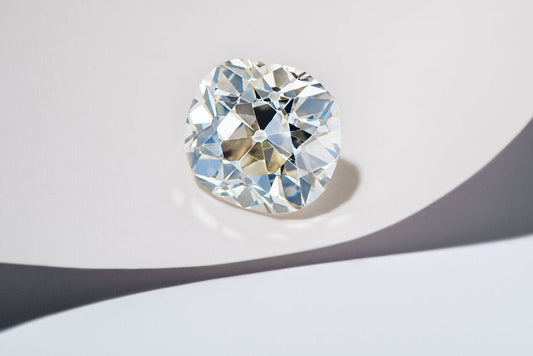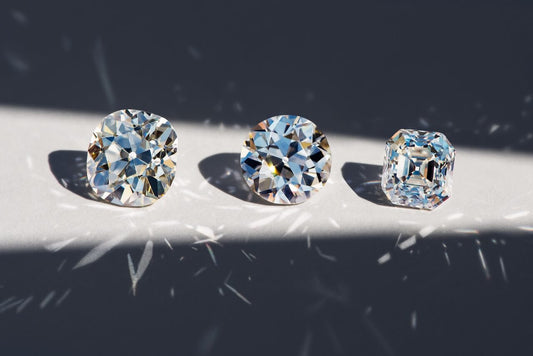7 TOP TIPS: THE EXPERT’S GUIDE TO BUYING A DIAMOND
Buying a diamond can feel intimidating. We’d like to help change that.
CUSHLA WHITING’s in-house rock expert, Hamish, is a GIA Gemologist and HRD Antwerp Diamond Grader. He possesses the most meticulous of eyes and unsurpassed knowledge. Hamish is based in Antwerp, granting us access to some of the rarest and most beautiful diamonds in the world. He shares his top seven tips for buying a diamond:
1. ALWAYS VIEW A DIAMOND IN NATURAL, DIFFUSED LIGHTING
Always look at the diamond in natural, diffused lighting—ideally a diamond-grading light. Many jewellers and Instagram sellers use sparkly LED lights to sell their diamonds. LED lighting masks visible inclusions and areas of light loss (due to bad cut proportions). Natural, diffused lighting shows the real brilliance of a diamond and the cut quality.
2. LOOK BEYOND THE CARAT WEIGHT
Diamonds vary in face-up size (the millimeter diameter) for the same carat weight. I can't assert this enough, the mistake consumers make is buying diamonds based on their carat weight rather than their overall millimeter size and cut quality. Diamond cutters have little incentive to cut diamonds well as they can sell heavier-cut, higher-carat-weight stones for higher prices.
3.LOOK BEYOND THE GRADE ON THE CERTIFICATE
Beware that individual clarity grades have a spectrum. Different diamond dealers or jewellers can have different definitions as to what “eye clean” is. Only a small percentage of SI1 diamonds are truly eye clean, and even not all VS2 graded diamonds are eye clean. So, never rely on a clarity grade to be confident that the diamond is eye clean unless you are looking at VS1 and above. You want an expert to “cherry pick” out the eye clean SI diamonds to get you the best value for money.
4. CUT IS KING
Unfortunately the GIA only provides a cut grade for round diamonds, all other shapes (fancy shapes) do not have a certified cut grade. Often misunderstood, even by people in the trade, the Polish and Symmetry grades give almost no indication of the beauty and overall quality of the cut. While these are important to an extent (it is generally recommended to buy a minimum of VG for modern diamonds), the GIA’s symmetry grade does not even take into account the optical symmetry of the diamond.
5. WORK WITH A DIAMOND EXPERT
Learning how to buy diamonds well takes years of experience and looking at many thousands of stones. There are many more factors an experienced diamond buyer takes into account when buying a diamond than the 4 c’s on the certificate. I can spend many hours, sometimes even days, going through hundreds of diamonds to cherry-pick just one. Often, I have to wait for new stones to be cut, or to be sourced, when there aren't any exceptional ones available on the international market.
6. DON'T NECESSARILY AVOID FLUORESCENCE
Fluorescence is misunderstood by many, even in the trade. In very rare cases, diamonds with strong to very strong fluorescence can appear milky or cloudy in natural light. However, the majority of diamonds with blue fluorescence do not have anything wrong with them. In fact, most times fluorescence will improve the diamond’s perceived colour. It is necessary for a trained and experienced diamond grader to check diamonds with medium to very strong fluorescence. Very strong blue fluorescence and sometimes strong fluorescent diamonds will have a slightly-bluish tinge to them in natural light. This may be something you find attractive as it adds extra coolness or “iciness” to the diamond. Or, it could be something you don't like. It’s a personal choice. Fluorescence gives a great discount to the diamond price, the only downside is that it may be harder to resell.
7. NEVER BUY A DIAMOND WITHOUT AN INDEPENDENT CUT ANALYSIS OF THE DIAMOND
This could be in the form of an Ideal Scope, Aset and or AGS cut grading system analysis. Unfortunately, most dealers or jewellers won't provide them. An independent cut analysis is important as the cut determines the beauty and brightness of the diamond and the GIA certificate does not give a cut grade for any shape other than the round diamond. Even in the case of the round diamond, the cut grade Excellent encompasses a vast range of parameters and we would generally only buy the very top of this grade.
—
Ready to meet our in-house diamond and design experts and feast your eyes on some of our incredibly rare diamonds? Book an appointment with one of our CUSHLA WHITING Design and Gemstone Consultants.


